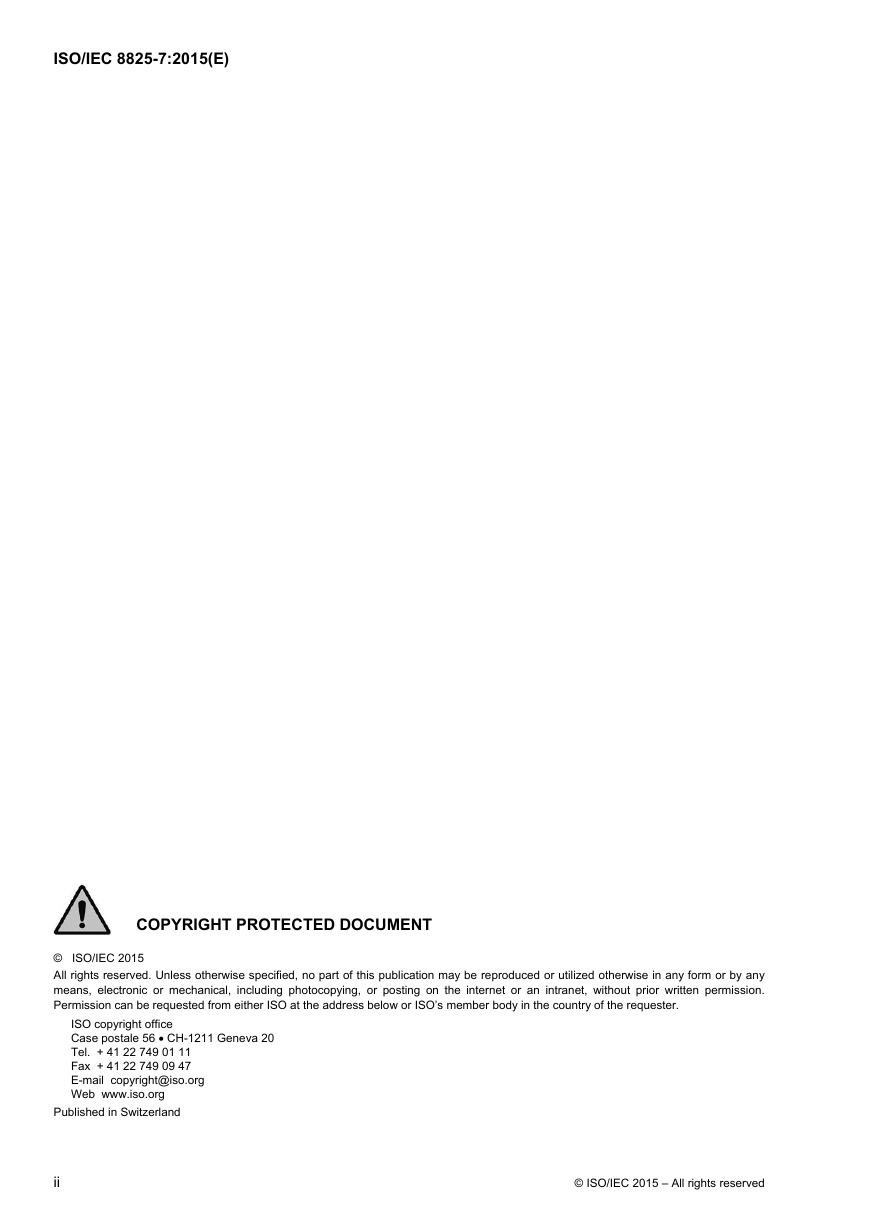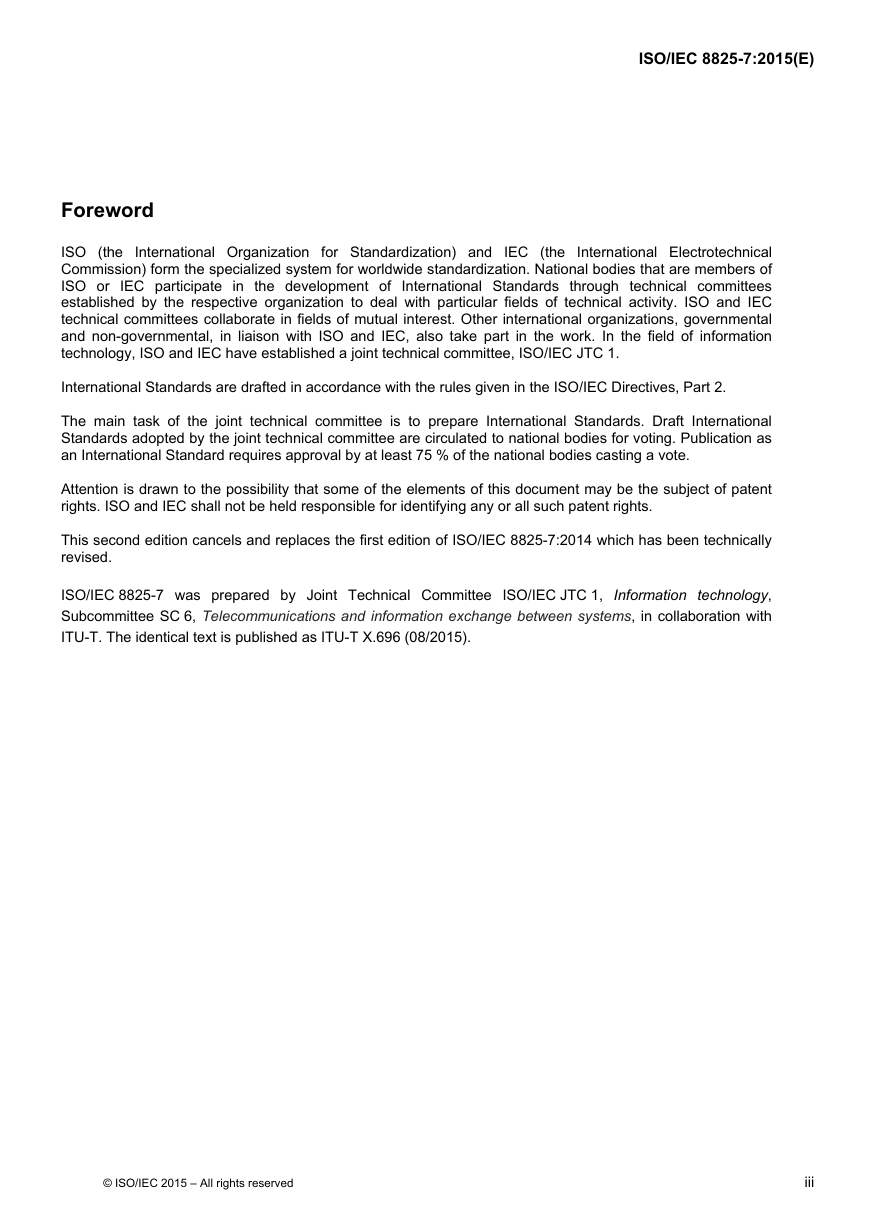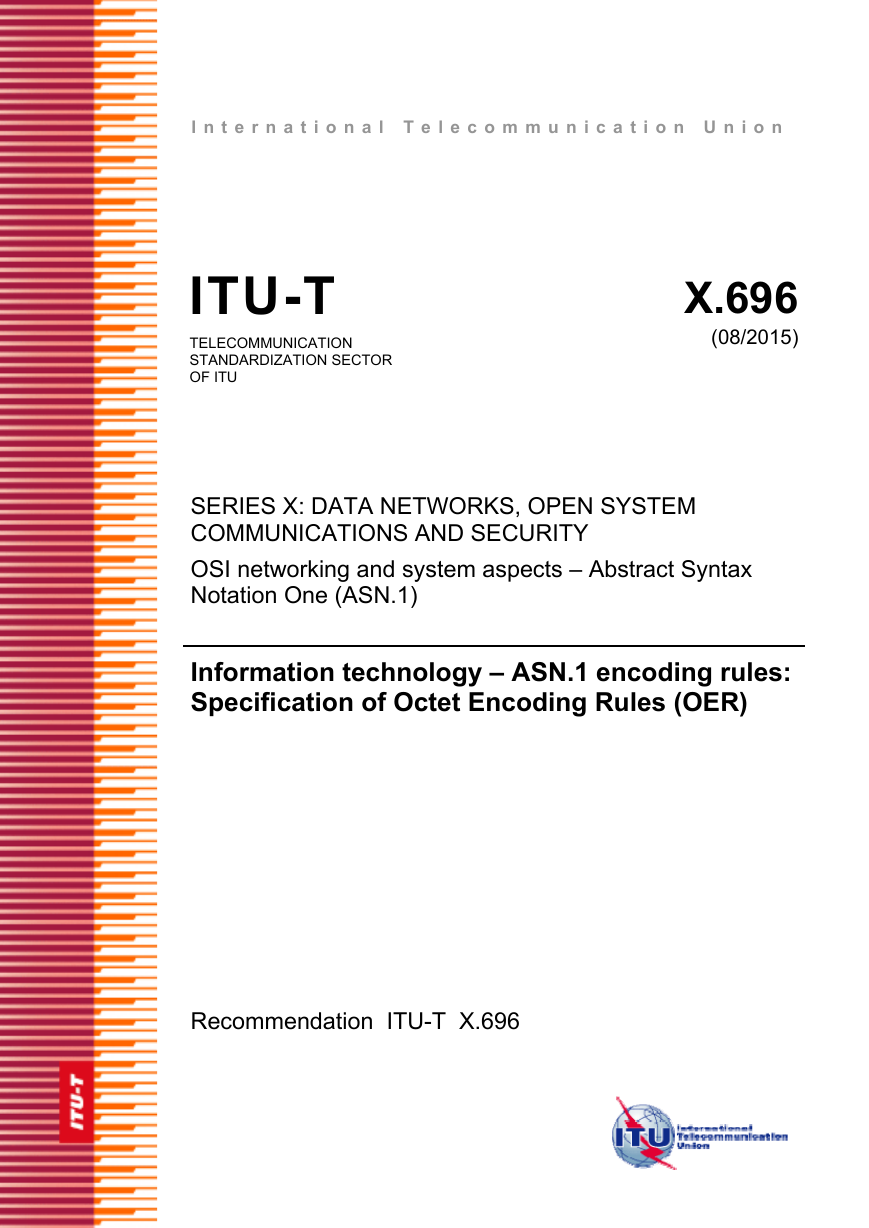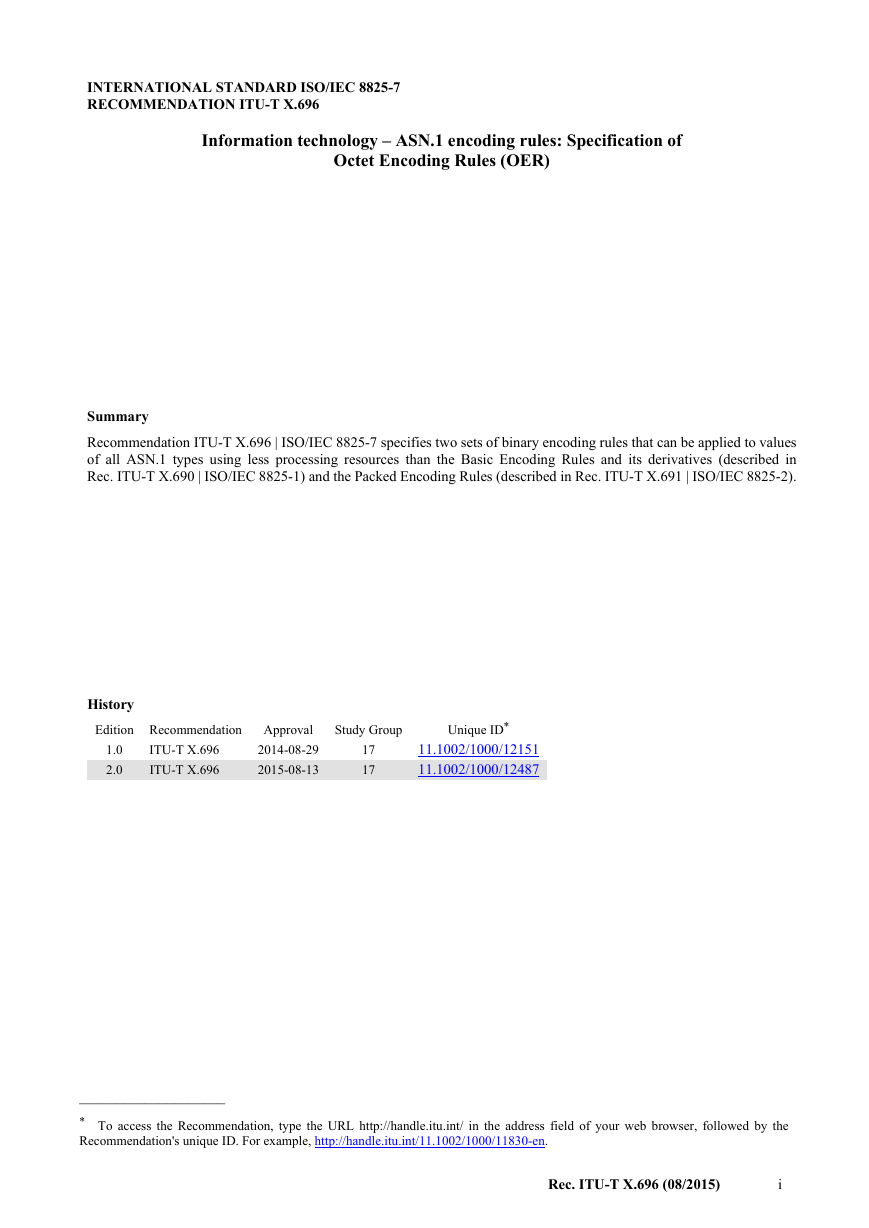INTERNATIONAL
STANDARD
ISO/IEC
8825-7
Second edition
2015-11-15
Information technology —
ASN.1 encoding rules: Specification of
Octet Encoding Rules (OER)
Technologies de l'information -- Règles de codage ASN.1: Spécification
des règles de codage des octets (OER)
Reference number
ISO/IEC 8825-7:2015(E)
© ISO/IEC 2015
�
ISO/IEC 8825-7:2015(E)
COPYRIGHT PROTECTED DOCUMENT
© ISO/IEC 2015
All rights reserved. Unless otherwise specified, no part of this publication may be reproduced or utilized otherwise in any form or by any
means, electronic or mechanical, including photocopying, or posting on the internet or an intranet, without prior written permission.
Permission can be requested from either ISO at the address below or ISO’s member body in the country of the requester.
ISO copyright office
Case postale 56 CH-1211 Geneva 20
Tel. + 41 22 749 01 11
Fax + 41 22 749 09 47
E-mail copyright@iso.org
Web www.iso.org
Published in Switzerland
ii
© ISO/IEC 2015 – All rights reserved
�
ISO/IEC 8825-7:2015(E)
Foreword
ISO (the International Organization for Standardization) and IEC (the International Electrotechnical
Commission) form the specialized system for worldwide standardization. National bodies that are members of
ISO or IEC participate in the development of International Standards through technical committees
established by the respective organization to deal with particular fields of technical activity. ISO and IEC
technical committees collaborate in fields of mutual interest. Other international organizations, governmental
and non-governmental, in liaison with ISO and IEC, also take part in the work. In the field of information
technology, ISO and IEC have established a joint technical committee, ISO/IEC JTC 1.
International Standards are drafted in accordance with the rules given in the ISO/IEC Directives, Part 2.
The main task of the joint technical committee is to prepare International Standards. Draft International
Standards adopted by the joint technical committee are circulated to national bodies for voting. Publication as
an International Standard requires approval by at least 75 % of the national bodies casting a vote.
Attention is drawn to the possibility that some of the elements of this document may be the subject of patent
rights. ISO and IEC shall not be held responsible for identifying any or all such patent rights.
This second edition cancels and replaces the first edition of ISO/IEC 8825-7:2014 which has been technically
revised.
ISO/IEC 8825-7 was prepared by Joint Technical Committee ISO/IEC JTC 1, Information technology,
Subcommittee SC 6, Telecommunications and information exchange between systems, in collaboration with
ITU-T. The identical text is published as ITU-T X.696 (08/2015).
© ISO/IEC 2015 – All rights reserved
iii
�
�
I n t e r n a t i o n a l T e l e c o m m u n i c a t i o n U n i o n
ITU-T
TELECOMMUNICATION
STANDARDIZATION SECTOR
OF ITU
X.696
(08/2015)
SERIES X: DATA NETWORKS, OPEN SYSTEM
COMMUNICATIONS AND SECURITY
OSI networking and system aspects – Abstract Syntax
Notation One (ASN.1)
Information technology – ASN.1 encoding rules:
Specification of Octet Encoding Rules (OER)
Recommendation ITU-T X.696
�
ITU-T X-SERIES RECOMMENDATIONS
DATA NETWORKS, OPEN SYSTEM COMMUNICATIONS AND SECURITY
PUBLIC DATA NETWORKS
Services and facilities
Interfaces
Transmission, signalling and switching
Network aspects
Maintenance
Administrative arrangements
OPEN SYSTEMS INTERCONNECTION
Model and notation
Service definitions
Connection-mode protocol specifications
Connectionless-mode protocol specifications
PICS proformas
Protocol Identification
Security Protocols
Layer Managed Objects
Conformance testing
INTERWORKING BETWEEN NETWORKS
General
Satellite data transmission systems
IP-based networks
MESSAGE HANDLING SYSTEMS
DIRECTORY
OSI NETWORKING AND SYSTEM ASPECTS
Networking
Efficiency
Quality of service
Naming, Addressing and Registration
Abstract Syntax Notation One (ASN.1)
OSI MANAGEMENT
Systems management framework and architecture
Management communication service and protocol
Structure of management information
Management functions and ODMA functions
SECURITY
OSI APPLICATIONS
Commitment, concurrency and recovery
Transaction processing
Remote operations
Generic applications of ASN.1
OPEN DISTRIBUTED PROCESSING
INFORMATION AND NETWORK SECURITY
SECURE APPLICATIONS AND SERVICES
CYBERSPACE SECURITY
SECURE APPLICATIONS AND SERVICES
CYBERSECURITY INFORMATION EXCHANGE
CLOUD COMPUTING SECURITY
For further details, please refer to the list of ITU-T Recommendations.
X.1–X.19
X.20–X.49
X.50–X.89
X.90–X.149
X.150–X.179
X.180–X.199
X.200–X.209
X.210–X.219
X.220–X.229
X.230–X.239
X.240–X.259
X.260–X.269
X.270–X.279
X.280–X.289
X.290–X.299
X.300–X.349
X.350–X.369
X.370–X.379
X.400–X.499
X.500–X.599
X.600–X.629
X.630–X.639
X.640–X.649
X.650–X.679
X.680–X.699
X.700–X.709
X.710–X.719
X.720–X.729
X.730–X.799
X.800–X.849
X.850–X.859
X.860–X.879
X.880–X.889
X.890–X.899
X.900–X.999
X.1000–X.1099
X.1100–X.1199
X.1200–X.1299
X.1300–X.1399
X.1500–X.1599
X.1600–X.1699
�
INTERNATIONAL STANDARD ISO/IEC 8825-7
RECOMMENDATION ITU-T X.696
Information technology – ASN.1 encoding rules: Specification of
Octet Encoding Rules (OER)
Summary
Recommendation ITU-T X.696 | ISO/IEC 8825-7 specifies two sets of binary encoding rules that can be applied to values
of all ASN.1 types using less processing resources than the Basic Encoding Rules and its derivatives (described in
Rec. ITU-T X.690 | ISO/IEC 8825-1) and the Packed Encoding Rules (described in Rec. ITU-T X.691 | ISO/IEC 8825-2).
History
Edition Recommendation Approval
2014-08-29
2015-08-13
ITU-T X.696
ITU-T X.696
1.0
2.0
Study Group
Unique ID*
17
17
11.1002/1000/12151
11.1002/1000/12487
____________________
* To access the Recommendation, type the URL http://handle.itu.int/ in the address field of your web browser, followed by the
Recommendation's unique ID. For example, http://handle.itu.int/11.1002/1000/11830-en.
Rec. ITU-T X.696 (08/2015)
i
�
FOREWORD
The International Telecommunication Union (ITU) is the United Nations specialized agency in the field of
telecommunications, information and communication technologies (ICTs). The ITU Telecommunication
Standardization Sector (ITU-T) is a permanent organ of ITU. ITU-T is responsible for studying technical,
operating and tariff questions and issuing Recommendations on them with a view to standardizing
telecommunications on a worldwide basis.
The World Telecommunication Standardization Assembly (WTSA), which meets every four years, establishes
the topics for study by the ITU-T study groups which, in turn, produce Recommendations on these topics.
The approval of ITU-T Recommendations is covered by the procedure laid down in WTSA Resolution 1.
In some areas of information technology which fall within ITU-T's purview, the necessary standards are
prepared on a collaborative basis with ISO and IEC.
NOTE
In this Recommendation, the expression "Administration" is used for conciseness to indicate both a
telecommunication administration and a recognized operating agency.
Compliance with this Recommendation is voluntary. However, the Recommendation may contain certain
mandatory provisions (to ensure, e.g., interoperability or applicability) and compliance with the
Recommendation is achieved when all of these mandatory provisions are met. The words "shall" or some other
obligatory language such as "must" and the negative equivalents are used to express requirements. The use of
such words does not suggest that compliance with the Recommendation is required of any party.
INTELLECTUAL PROPERTY RIGHTS
ITU draws attention to the possibility that the practice or implementation of this Recommendation may involve
the use of a claimed Intellectual Property Right. ITU takes no position concerning the evidence, validity or
applicability of claimed Intellectual Property Rights, whether asserted by ITU members or others outside of
the Recommendation development process.
As of the date of approval of this Recommendation, ITU had not received notice of intellectual property,
protected by patents, which may be required to implement this Recommendation. However, implementers are
cautioned that this may not represent the latest information and are therefore strongly urged to consult the TSB
patent database at http://www.itu.int/ITU-T/ipr/.
ITU 2015
All rights reserved. No part of this publication may be reproduced, by any means whatsoever, without the prior
written permission of ITU.
ii
Rec. ITU-T X.696 (08/2015)
�
















 2023年江西萍乡中考道德与法治真题及答案.doc
2023年江西萍乡中考道德与法治真题及答案.doc 2012年重庆南川中考生物真题及答案.doc
2012年重庆南川中考生物真题及答案.doc 2013年江西师范大学地理学综合及文艺理论基础考研真题.doc
2013年江西师范大学地理学综合及文艺理论基础考研真题.doc 2020年四川甘孜小升初语文真题及答案I卷.doc
2020年四川甘孜小升初语文真题及答案I卷.doc 2020年注册岩土工程师专业基础考试真题及答案.doc
2020年注册岩土工程师专业基础考试真题及答案.doc 2023-2024学年福建省厦门市九年级上学期数学月考试题及答案.doc
2023-2024学年福建省厦门市九年级上学期数学月考试题及答案.doc 2021-2022学年辽宁省沈阳市大东区九年级上学期语文期末试题及答案.doc
2021-2022学年辽宁省沈阳市大东区九年级上学期语文期末试题及答案.doc 2022-2023学年北京东城区初三第一学期物理期末试卷及答案.doc
2022-2023学年北京东城区初三第一学期物理期末试卷及答案.doc 2018上半年江西教师资格初中地理学科知识与教学能力真题及答案.doc
2018上半年江西教师资格初中地理学科知识与教学能力真题及答案.doc 2012年河北国家公务员申论考试真题及答案-省级.doc
2012年河北国家公务员申论考试真题及答案-省级.doc 2020-2021学年江苏省扬州市江都区邵樊片九年级上学期数学第一次质量检测试题及答案.doc
2020-2021学年江苏省扬州市江都区邵樊片九年级上学期数学第一次质量检测试题及答案.doc 2022下半年黑龙江教师资格证中学综合素质真题及答案.doc
2022下半年黑龙江教师资格证中学综合素质真题及答案.doc